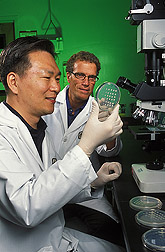Nuts’ New Aflatoxin Fighter: Caffeic Acid?
|
|
Crunchy, good-for-you nuts like almonds, pistachios, and walnuts make their way to your local supermarket only after they’ve passed a rigorous safety test. The assay ensures that the nuts are free of unsafe levels of aflatoxin, a natural, cancer-causing compound.
A fungus, or mold, known as Aspergillus flavus is a leading maker of aflatoxin. Now, ARS scientists Bruce C. Campbell and Jong H. Kim and their colleagues have discovered what might be done to stop that from happening.
Campbell leads the Plant Mycotoxin Research Unit at ARS’s Western Regional Research Center in Albany, California. Kim is a postdoctoral molecular biologist with the team.
When the mold feeds on certain kinds of tree nuts, the nuts respond by forming compounds called “oxidants,” explains Campbell. The oxidants, in turn, cause what’s known as “oxidative stress” in the mold. The mold’s reaction? Produce aflatoxin.
But compounds called “antioxidants” can, as their name implies, counter the oxidative stress. And, in doing so, they can quell nearly all aflatoxin production, the scientists found.
The studies could lead to safe, Earth-friendly ways to put antioxidants to work in tree-nut orchards. For example, antioxidants could be applied to trees, or perhaps the trees’ own supply of antioxidants could be bolstered through plant breeding.
Three Antioxidants Scrutinized
In laboratory experiments, Campbell and Kim grew colonies of the mold on extracts of walnut and pistachio. Next, they exposed the colonies to three compounds thought to be antioxidants: gallic acid, which ARS chemist Russell J. Molyneux and co-researchers discovered has aflatoxin-combating prowess in walnuts, and chlorogenic acid and caffeic acid, two compounds commonly found in coffee beans.
Caffeic acid outperformed the other antioxidants, reducing aflatoxin production by more than 95 percent. The studies are the first to show that oxidative stress that would otherwise trigger or enhance A. flavus aflatoxin production can be stymied by caffeic acid.
Caffeic acid is a natural ingredient not only in coffee beans but also in apples, bell peppers, pears, and other crops.
When it suppresses aflatoxin production, caffeic acid is thwarting the mold’s aflatoxin genes. Pinpointing these guilty genes could widen the array of new tactics to undermine them. So Campbell and Kim have teamed with ARS plant geneticist Jiujiang Yu of the ARS Southern Regional Research Center, New Orleans, Louisiana, who is currently working at the Institute for Genomic Research in Rockville, Maryland. (See "Killer Fungi" story in this issue.)
Using microarray technology, Kim took successive snapshots that captured the actions of one form of the mold’s genetic material, messenger RNA. He did that before the caffeic acid was applied and at 4 and 6 days after.
Yu, Campbell, and Kim found that 48 genes responded to the antioxidants. About half a dozen of these genes were not known to be involved with aflatoxin but may in fact be key players.—By Marcia Wood, Agricultural Research Service Information Staff.
Bruce C. Campbell and Jong H. Kim are with the USDA-ARS Western Regional Research Center, 800 Buchanan St., Albany, CA 94710; phone (510) 559-5846 [Campbell], (510) 559-5841 [Kim], fax (510) 559-5777.
"Nuts’ New Aflatoxin Fighter: Caffeic Acid?" was published in the October 2006 issue of Agricultural Research magazine.







